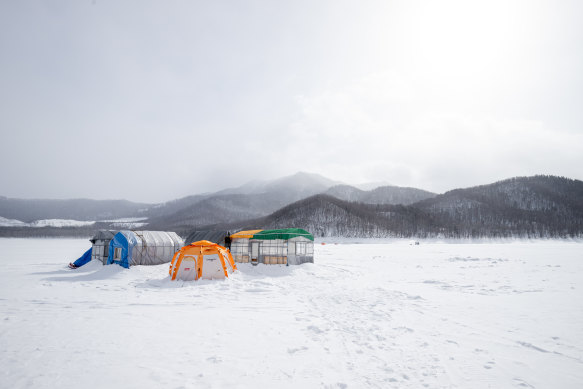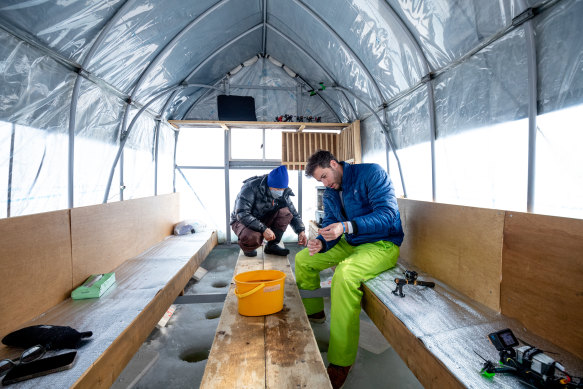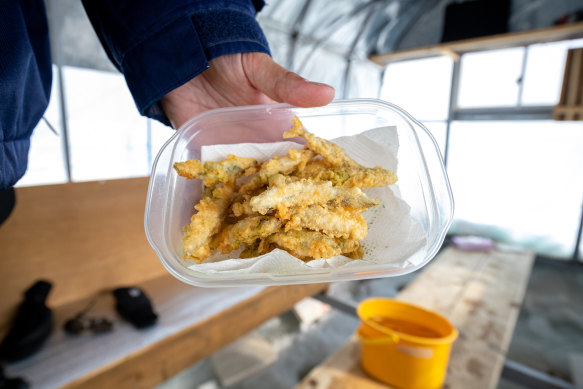Forget expensive wellness programs: Relax with this Japanese pastime instead
“Watch out for that big crack. You might fall through”, says Tek Gurung as he steps over a jagged line in the ice. It’s not what you want to hear from your guide as you make your first tentative steps out onto a vast frozen lake. Tek seems completely nonplussed as he continues his way over the white expanse, while I take a cautiously large step over the crack and follow him across Lake Kanayama, a popular ice-fishing spot in central Hokkaido’s Furano prefecture.

The temporary ice fishing village on Lake Kanayama, Hokkaido, Japan.Credit: Justin Meneguzzi
Tek tells me he usually works as a white-water rafting guide during summer, when the surrounding mountains are tickled pink by vast fields of wild lavender and holidaymakers camp by the water. Biting Siberian winds arrive in November, delivering northern Japan’s famous snow dumps and delighting ski fanatics, so Tek pivots to teaching ice fishing in winter instead.
Snow has always been a challenge for Hokkaido. On the drive to Lake Kanayama, we pass houses that have partially collapsed under a thick belt of snow. In the past, before the arrival of Japan’s famously well-stocked 7/11 convenience stores, hunting was made difficult as game burrowed underground or hibernated. During those leaner months, resourceful Hokkaidans turned to ice fishing for sustenance.
Nowadays, ice fishing, known as “wakasagi tsuri”, has evolved into a cultural pastime that anyone can enjoy if they’re willing to brave the cold. Following back-to-back days of snowboarding on deep powder snow at Club Med Tomamu, I decide to give my glutes a day off and try my hand with a fishing rod.
Light snow is falling as we trek a few hundred metres out into the middle of the lake to where an industrious-looking temporary fishing village has popped up. Two large metal huts stand alongside a makeshift kitchen housed inside a yellow geodesic tent. I peer in through the window of the first hut and can make out the blurred shapes of a dozen Japanese men all sitting like hunched statues.
I’m ushered along into the second hut where inside, I find two rows of makeshift timber benches facing each other. Spaced evenly below the benches are a dozen dinner-plate sized holes that have been drilled about 60-centimetres down into the ice. Waiting for us are toy-sized, almost dainty, fishing poles that have been prepared with three baited hooks. A heater in the corner provides enough warmth for us to take off our jackets.

Inside the ice fishing tent.Credit: Justin Meneguzzi
Tek walks me through the basics of fishing, which essentially boils down to “if the line starts dancing, pull hard.” What sounds easy in theory proves challenging in practice. This is because we’re fishing for wakasagi, a species of tiny fish known as smelts that are roughly the same size as your little finger. Native to Hokkaido and highly sought after, the fish has since been introduced to lakes across Japan for locals to enjoy in winter. Whereas a tug from a larger fish might be easier to spot on the line, these gentle fish make near imperceptible pulls that require careful observation.
Over the next hour, Tek and I settle into a comfortable silence watching our lines. With the world narrowed down to just a single hook in front of me, it’s an intensely meditative experience. I can’t help but think of the fancy hotels and retreats offering new age wellness programs featuring digital detoxes and silence retreats, yet one of humanity’s oldest pastimes and inventions – the humble fishing rod – still manages to hold its own.
My thoughts are suddenly swept away in a rush of adrenaline as my fishing line starts dancing. One after the other, I’m pulling little wakasagi out of the icy water and I soon have 20 of them darting about in my yellow fishing bucket.

Fresh catch – tempura wakasagi. Credit: Justin Meneguzzi
Tek disappears with our catch and shortly returns with a bowl of flash fried tempura wagasaki, which he has dusted in a green pepper powder. They make a deliciously crunchy snack to munch on.
Bracing the cold, we start our trek back across the lake when suddenly the huts erupt with excited shouts. A guide runs out onto the ice after us waving my abandoned fishing rod high in the air like a flag. It takes a minute before I realise why he’s so happy: three silver fish, one on each of the hooks, are flailing in the frigid wind. It’s a sign of good luck to come.
Justin Meneguzzi travelled as a guest of Club Med.
The details
Fly
Japan Airlines, Qantas, Cathay Pacific and Thai Airways fly regularly from Melbourne and Sydney to Sapporo via Tokyo.
Stay
Club Med Tomamu offers all-inclusive holiday packages at its ski-in/ski-out resort. Packages start from $4400 and include lift passes, group ski/snowboard lessons, food, drinks and kids club. Optional wakasagi ice fishing excursions are available from ¥5600 ($60). See clubmed.com.au
Sign up for the Traveller Deals newsletter
Get exclusive travel deals delivered straight to your inbox. Sign up now.